Crop sprayers continue to develop. The basic principal remains; a liquid solution is delivered through a precisely shaped nozzle, at a set pressure to deliver a distribution of droplets on the target plant, weed or soil. Modern sprayers can do this more accurately and with a greater degree of control than before. The concept of precision spraying using SMART sprayers promises even more-targeted application with the potential to reduce pesticide use and lessen resistance development while retaining efficacy.
SMART /Precision Spraying
While a conventional spraying operation strives to apply the product evenly across an entire field, the SMART/precision approach is targeted; only applying the chemical on plants or parts of the field that would benefit from it and at appropriate rates. To achieve this level of precision there are at least three essential components:
- A sensing system which can measure differences in crop, soil or weed which forms the basis for variable application or spot treatment. These sensors can be vegetation, or occasionally soil, sensors that may be tractor-mounted, drone-mounted, satellite based or indeed held by a user.
- A response function based on research, which determines what is to be done. If a weed area is identified, it is sprayed with herbicide, but if a disease focus is identified, meteorological data and modelling may be used to determine if only that focus is treated or the entire field.
- Spraying technology that allows the rate to be varied or product to be added to respond to demands for variable rate or spot spraying. This needs to be done fast enough and at a resolution (i.e. treated width or area) that matches that of the information provided.
The resulting application can be divided into three categories:
- Variable rate application: involves changing the rate of the product being applied based on measured variability. The resolution or size of the area over which this the variability is applied will depend on the measuring and/or application technology.
- Patch spraying: this is a where specific areas of the field, perhaps where weeds are present or a disease focus is identified, is sprayed with a particular product and other areas are not treated.
- Spot spraying: this is like patch spraying except it implies that the spray can be targeted to a much smaller area and may be targeting a single weed for example.
Variability Sensors
While there are many characteristics of crop and soil that can be measured, those that are used in real-time are often ‘multi-spec’ or ‘RGB’ image sensors which measure part of the electromagnetic spectrum, part of what we see as colour; but it includes non-visible wavelengths also. LIDAR distance type sensors are also used. By fine tuning what is measured and processing the data, these can be used to identify the presence of plants, perhaps identify the plant types (weed or crop), and even measure plant stress (disease or drought).
Nozzles and Nozzle Control Technology
Fan nozzles, whether air- induction or standard, are versatile and suit uniform application. However they are quite limited for variable rate application. Using spray pressure to alter rate impacts negatively on spray quality, drift and crop penetration. Changing forward speed will change application rate, but this impacts on work rate and can only work across the entire boom width (12 to 36m). Three newer nozzle technologies give variable rate control options:
- Mechanical metering nozzle: these nozzle bodies have a variable orifice, usually controlled by the sprayer pressure, which increases as pressure increases. With a conventional nozzle a doubling of pressure from 2 to 4 bar may increase the output by just 40%, but with a ‘Varitarget’ variable orifice nozzle that change would give a 350% increase in output. But these nozzle types struggle to maintain the degree of output control required for precise fungicide or herbicide use. Another variant the ‘Turbodrop variable rate’ has one orifice spraying continuously with a second orifice opening when pressure is increased. Nozzle types which rely on pressure change to vary the opening need very good pressure control systems. They have not had a lot of application in Europe.
- Multi-nozzle switching options at each nozzle point: examples of this increasingly available technology include Exactapply (John Deere) Amaselect (Amazone) Seletron (Arag) and Duo react (Hypro). These automatic switching nozzle holder units can have up to 5 nozzles of different size controlled electronically and can switch instantaneously, in demand to required output changes. While the spraying pressure remains constant across the boom, the availability of say 02, 03, 04 and 05 size nozzles available to work singly, or in combination, allows a range of outputs to be automatically selected at each nozzle point giving the possibility of variable rate application at each individual nozzle position. In addition this system can compensate for differences in boom speed as it turns a corner or curve.
- Pulse Width Modulation (PWM): concept of PWM sprayer control is quite simple. Instead of the spray flowing continuously through the nozzle, it can be ‘pulsed’ through it to reduce the flow. The term ‘pulse width modulation’ comes from the electronic control circuit used, which is more typically used to control electric motor speeds. In a spraying application, the pulses may occur at 10 Hz up to 100Hz i.e. 10 to 100 times per second. At maximum flow the nozzle is spraying continuously but at 50% flow the nozzle is only open half of the time (50% duty cycle), so for each pulse, it is on and off for equal lengths of time, but there are 10 – 100 pulses per second. These systems typically allow up to a four or five fold change in output e.g. from 200 litres/ha down to 50 litres. The spray line and solenoid system must hold the system pressure perfectly to ensure each short pulse delivers a proper spray pattern at the instant that it is spraying. Typically every second nozzle is working on the opposite phase so when one is pulsing on, the adjacent nozzle is off, which reduces the risk of crop being ‘missed’ at low duty-cycle rates and higher forward speeds. The higher pulse rates (20-100hz) reduces the risk of missed crop. This system is well suited to variable rate application as it can maintain spray quality (droplet size, penetration and coverage) across a range of outputs and the instantaneous on/off and individual nozzle control that the system allows is particularly suited to spot spraying. PWM does not work well with air induction nozzles. There are a number of manufacturers working on, or offering PWM systems including Teejet, Amazone, Raven, Agrifac.
Delivering Different Products on a Variable Basis
Where a SMART spraying system requires additional spray products (e.g additional herbicide) rather than just a variable rate, to be added for spot-spraying or patch-spraying, there are a number of delivery options possible:
- Separate spray pass: sprayer delivers the main product first and then delivers the additional product in a separate run in ‘patch’ or ‘spot’ spray mode using the necessary sensor/map based control technology.
- Multi line systems: requires a completely separate spray line system (including separate nozzles and spray tank) on the boom and would typically have a spray line delivering an overall product at a constant application rate, and then; a spot or patch treatment line complete with necessary sensor/map based control technology, to deliver a second product at a variable rate to spots or patches within fields.
- Dosing or direct injection system: in this system, the undiluted pesticide products are held separately from the diluent (water) which is circulating through the spray line. The pesticide products are accurately metered into the supply while spraying with very precise metering and mixing equipment. This would typically follow an application map applying fungicide at a constant rate and adding herbicide as determined by the controlling application map. While this allows almost endless mixing and application possibilities, it is complex, expensive and involves handling of undiluted product.
- Drone delivery: the hype around drones continues in agriculture and is justified in many areas. In precision approaches, the drone’s ability to carry cameras/multi-spec sensors is useful, but drones could potentially deliver and apply pesticide to patches or perhaps to spots where a field requires a very small amount of patch or spot spraying.
Bringing it All Together
The concepts of precision spraying discussed here exist for at least 30 years, but development has been slow as it relies on research on sensors, positioning, data processing (including machine learning / artificial intelligence), response models/algorithms and sprayer control, to bring these concepts to a working model. While there has been progress on components, we are only now seeing complete systems being put together in configurations that may result in large scale application in the future and crop sprayers will continue to develop.
Amazone’s recent announcement of field trials with a SMART sprayer indicate the level of collaboration necessary to bring the necessary technology together. Amazone produce the sprayer and its controls, Bosch produce the camera sensor used to scan the crop and identify the weeds and Xarvio, a BASF company, provide the software that determines the sprayer response. The sprayer uses PWM to allow accurate application on a spot basis to the identified weeds and a conventional sprayer line is available for simultaneous overall spraying with a separate product. While the three commercial companies are working together on this smart sprayer, the technologies being built-on had their origins in many university and research Institute projects. There are many research and commercial groups working on these technologies.
Source: Teagasc



